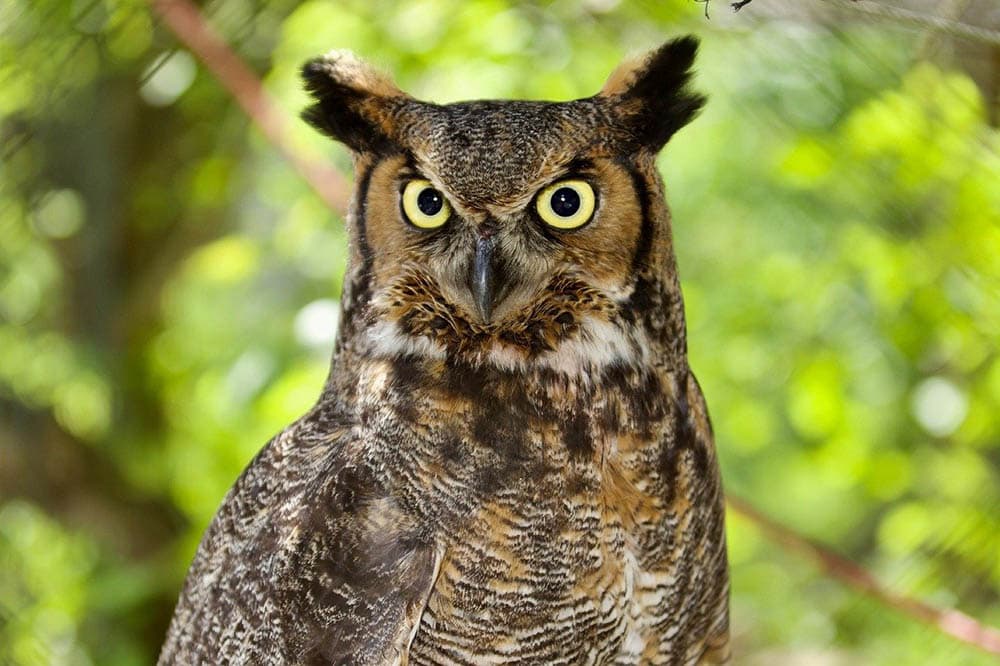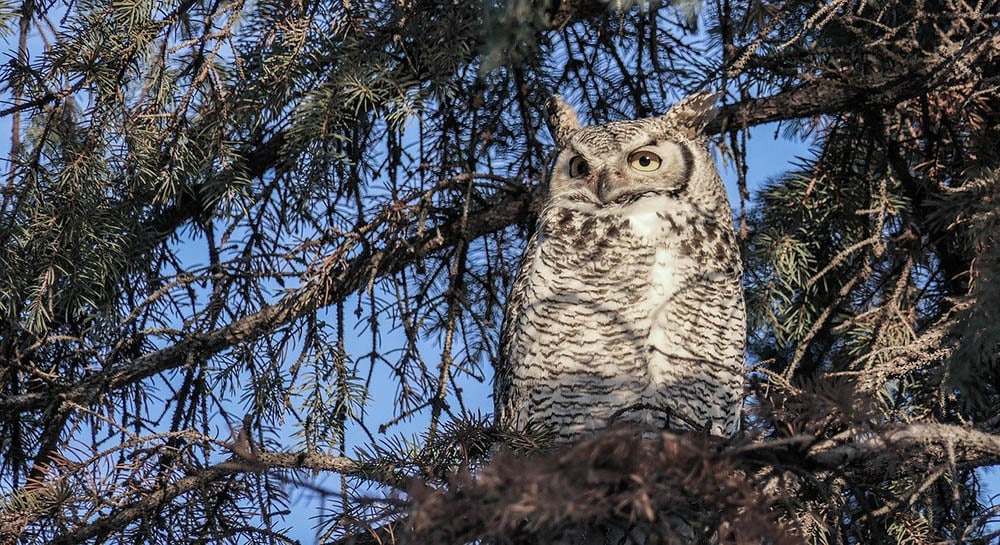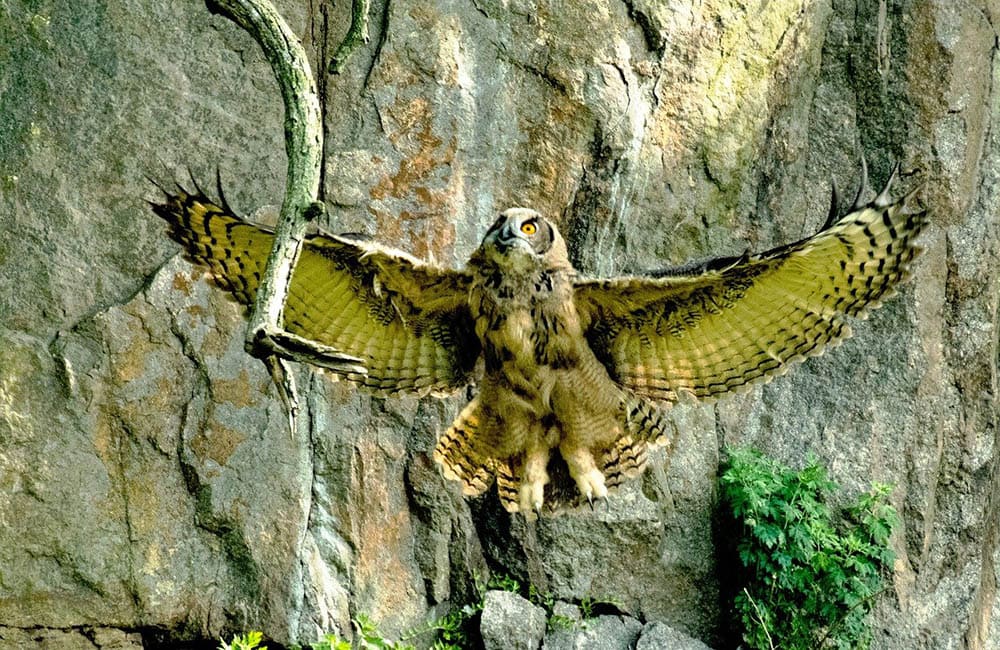Great Horned Owl Wingspan: How Big it Is & How it Compares to Other Birds
Last Updated on

| Species Name: | Bubo virginianus |
| Population: | 5 million |
| Range: | North America, Central America, South America |
Named for the tufts of feathers on its head that look like horns, the Great Horned Owl is a bird of prey with incredible hearing, a head that can rotate 270°, and a diet that consists of other birds and small mammals including the skunk.
The population of this owl is considered stable, which means that it is not under any specific threat, and it is considered beneficial to human populations because it is an effective rodent controller. The owl weighs just three pounds and has a wingspan of around 4.5 feet. Its wings facilitate silent hunting because they have soft edges, enabling it to fly silently while hunting its quarry.

Great Horned Owl Wingspan

The Great Horned Owl is considered a large owl species and is larger than a crow but smaller than a goose. It is nocturnal, so you will rarely see one, but it is recognizable for the tufts of feathers on either side of the head. Weighing three pounds, the owl is completely covered in feathers and has a wingspan between three and five feet. As is typical with birds of prey, the female of the species is considerably larger than the male.
| Wingspan Range | Average Wingspan | |
| Male Great Horned Owl | 35-50 inches
90-127 cm |
40 inches
102 cm |
| Female Great Horned Owl | 45-60 inches
114-152 cm |
50 inches
127 cm |
How Is Wingspan Measured?
Wingspan is the total length of a pair of wings measured from the tip of one wing right across the bird’s back and to the tip of the other wing. It is measured when the wings are fully outstretched. Scientists may capture the bird to measure the wings of a live sample, but they also measure the wings of dead birds to get an accurate range of measurements.

Great Horned Owl Wingspan Compared to Other Birds of Prey
Owls are known for having a large wingspan compared to their weight. In the case of the Great Horned Owl, a female typically weighs as little as three pounds but has an impressive 5-foot wingspan. This kind of ratio is unique to owls, which are also one of the few types of birds to have soft wing edges to enable silent flight.
Although the Great Horned Owl is considered one of the largest owls native to the US, the Snowy Owl, which is the largest, has a much wider wingspan, measuring approximately 5.5 feet.
And, while the Great Horned Owl is one of the largest owls, it is small compared to many other native birds of prey. The California Condor, for example, has a wingspan stretching ten feet, nearly twice the length of the owl.
The largest flying bird in the world is the Wandering Albatross. Its 11-foot wingspan enables it to travel thousands of miles in a single journey and this seabird spends months on the wing and while it may tough down on the water to catch squid and other prey, it can go for periods longer than a year without touching dry land.

| Wingspan Range | Average Wingspan | |
| Snowy Owl | 54-65 inches
137-165 cm |
60 inches
152 cm |
| California Condor | 100-120 inches
250-305 cm |
105 inches
265 cm |
| Bald Eagle | 70-90 inches
180-230 cm |
84 inches
213 cm |
| Great Gray Owl | 53-61 inches
135-155 cm |
56 inches
142 cm |
Are All Bird Wings the Same?
A bird’s wings are shaped and contoured according to how they are used. Birds that need quick bursts of speed to catch agile prey have different wings to those that need to cover very long distances with minimal effort. Owl wings are unique for several reasons. They are very large, compared to the weight and size of the bird. This means that they can fly slowly and they use this slow soaring capability to spot and hunt mammals and other prey. The bird’s secondary feathers are very soft, which reduces drag and virtually eliminates any noise the owl makes while in flight: again, optimal for hunting their prey.
Small birds have elliptical wings. These allow for acrobatic maneuvers, including the ability to quickly ascend and descend during flight and to get out of the way of predators like the Great Horned Owl.
Falcons and other birds that feed on the wing, or in flight, have high-speed wings that are long and have minimal drag.
Long-soaring wings are found on albatrosses and other long-flight species allow the birds to cover considerable distances without expending huge amounts of energy.
Broad soaring wings, which are medium to long, allow the bird to fully take advantage of air currents to cover distance and for soaring while hunting.
You might also be interested in: Andean Condor Wingspan: How Big it Is & How it Compares to Other Birds

In Conclusion
The Great Horned Owl is a nocturnal bird so although it is considered plentiful, you will rarely see them in the wild. As an owl, it has a large wingspan compared to the weight of its body and its wings have a soft edge: this combination allows for fast flight and silent hunting. Its wingspan, which can reach up to 5 feet, makes it a large species of owl, although its wing size is eclipsed by other birds of prey.
Related Read: 53 Fascinating & Fun Owl Facts You Never Knew
Featured Image Credit: Pixabay
About the Author Robert Sparks
Robert’s obsession with all things optical started early in life, when his optician father would bring home prototypes for Robert to play with. Nowadays, Robert is dedicated to helping others find the right optics for their needs. His hobbies include astronomy, astrophysics, and model building. Originally from Newark, NJ, he resides in Santa Fe, New Mexico, where the nighttime skies are filled with glittering stars.
Related Articles:
How to Collimate Binoculars: 9 Expert Tips
Binocular Magnification Chart: Numbers & Distances Compared
How to Clean a Refractor Telescope: Step-by-Step Guide
How to Clean a Telescope Eyepiece: Step-by-Step Guide
How to Clean a Rifle Scope: 8 Expert Tips
When Were Binoculars Invented? History, Today & Future
Can You Use Binoculars to Look At Stars? How to Choose the Right Pair
How to Choose Binoculars for Bird Watching: 10 Expert Tips
